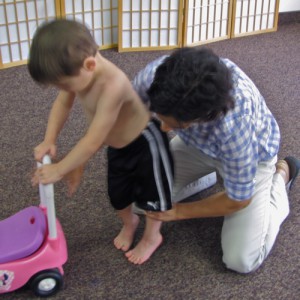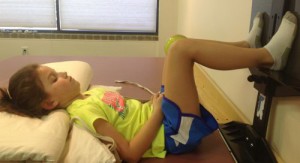Do you or someone you know have a child who tends to walk on his or her toes for no apparent reason?
Do you find yourself noticing your child walking on his or her toes even if you ask them to put their heels down?
Do you notice the child standing on his or her toes more often then they have their heels down?
Does it seem like they just can’t help it?
Well, for some toddlers, walking on their toes when they are just learning to walk may be OK; however, as they improve their balance, it should go away.
For children older than 2 years of age, toe walking can make running, jumping, climbing and playing more difficult, or may begin to attract unwanted attention from peers.
Though the medical field doesn’t always know why children walk on their toes, we have been able to identify some similar postures and movement patterns of these children. In conjunction with the philosophies of Postural Restoration Institute, it has been found that the way a child breathes may have everything to do with the way they move and walk.
Do you notice that your child, who walks on his or her toes, also:
– stands with his or her belly forward and back arched?
– has trouble standing still and always seems to need to move his or her feet to stay balanced?
– has trouble sitting still and seems to be extra wiggly compared to peers?
– has trouble completing a seated table-top task and needs to get up and move around?
– yawns often even though they do not seem to be tired?
– sleeps on his or her back with arms overhead, back arched, and mouth open?
– uses an inhaler or has a diagnosis of asthma?
If you notice any of these postures or behaviors your child may have developed an atypical method of breathing. When children use different muscles to breathe, they also tend to use different muscles to move…. And to walk!
Here’s a quick test you can use to see if it seems like your child, who walks on his or her toes, may have developed an atypical pattern of breathing:
Ask your child to lie on his or her back with feet toward a wall. Help the child slide forward so feet are as flat as they can go on the wall (heels touching the surface). Slide the child forward enough to get his or her hips and knees bent 90 degrees (knees should be directly over hips). Prop up their head and shoulders on at least 3 pillows so their back is in a rounded position. Now watch…..
Does the child tends to be quite wiggly? Do they need to have their arms overhead? Do they not want to stay in this position for more than a couple of minutes? It may be because they can’t breathe in this position! Watch closely to see what happens after the child stands up. If the child tends to take a huge breath with his or her back arched or to yawn, they might be telling you that they weren’t getting enough air in while they were on the floor with their backs rounded forward. This child may only be able to breathe sufficiently if their backs are arched and toes are pointed.
Further… if your child, who walks on their toes, is close to or older than 10 years of age, see if he or she can blow up a balloon in the above position. If they can’t blow up the balloon while curled up on the floor, but can while standing (and probably arching their back), your child might have an atypical breathing pattern related to his or her toe walking.
Our staff at Advance Physical Therapy is specially trained to consider and to address patterns of breathing when treating children (or adults!) who might walk on their toes. Our goal is to help them learn to use their respiratory system (breathing muscles) to help them relax other muscles to bring their heels down. We would love the opportunity to evaluate your child and to offer some activities you can do at home to help normalize their breathing patterns, movement, and walking with their heels down.
GO HEELS!!!
(no pun intended…. OK, maybe a little intended!)





